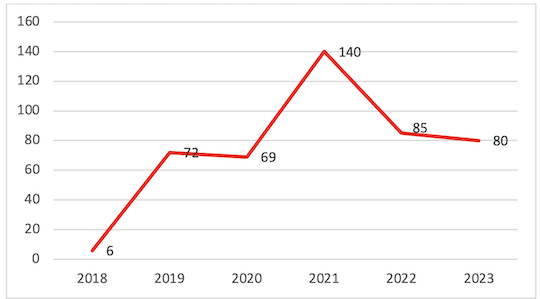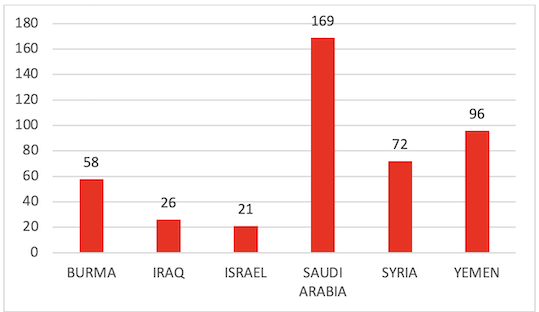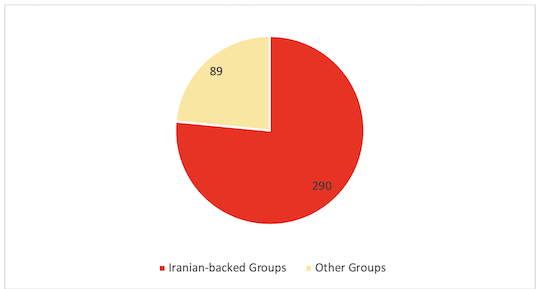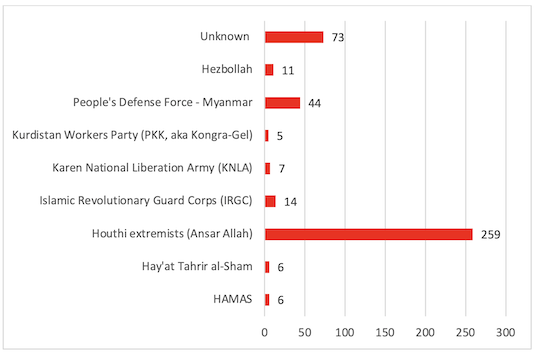drones
Perspective – Send in the Robots: Counter-Terrorism Response and Emerging Drone Technology
About the Author(s)
Perspective – Drone Proliferation in the Conflict Zones: Who are the Suppliers and Users?
Mahmut Chengiz
The 7 October 2023 Hamas terrorist attacks have increased tension in the Middle East, and attacks by Iran-backed militia groups threaten United States (US) officials, interests, and American military bases. These groups have already launched multiple drone attacks on US forces in Iraq and Syria. US officials are worried about being exposed to a ramping-up of attacks by these militia groups targeting Americans.
Unmanned Aerial Vehicles (UAVs), also known as drones, have evolved from reconnaissance tools to deadly weapons. Drones play critical roles in changing wars and become tools in the hands of fighting groups in the conflict zones. Increasing interest in acquiring drones makes its proliferation inevitable, and today, state actors and non-state actors, composed of militia groups, insurgents, and terrorist organizations, procure these drones. Its deployment in the conflict regions complicates the security environment further.
States have deployed drones to provide round-the-clock surveillance and carry out targeted strikes, even in foreign countries, which could result in legal and human rights issues. In some cases, these drones violate territorial sovereignty and cause collateral damage, raising questions about legality, secrecy, and absence of government accountability.
Among the non-state actors, terrorist organizations occupy a special place in deploying more complex and technological weapons. Terrorist groups are rarely random and senseless in their tactics and prefer weapons that can cause high impact and more deaths. The Annex of Statistical Information: Country Reports on Terrorism 2021 enumerates a variety of weapon types used by terrorist organizations, ranging from firearms, Improvised Explosive Devices (IEDs), incendiaries, and mines, to rockets, grenades, mortars, and knives. The most prevalent weapon type is firearms, followed by IEDs. UAVs are another weapon type that receives increasing interest from terrorist groups.
A specific focus on UAV deployment shows that the Global Terrorism Trends and Analysis Center (GTTAC) Incidents Records of Database (or GRID) recorded 452 incidents from 2018 to the first nine months of 2023. These incidents were attributed to a specific perpetrator in 379 incidents, and 73 incidents were by unknown perpetrators. The breakdown of these incidents in the same period indicated that drone attacks were the highest in 2021 but then decreased in 2022, as seen in Figure 1 below. However, there will likely be an uptick at the end of the year in 2023, given the fact that the US military bases in Syria and northern Iraq, after Hamas’s 7 October 2023 terrorist attacks, have been targeted with drones by Iran-backed groups.

Figure 1: UAV Attacks from 2018 to 2023 (January through September)
Figure 2 below shows the countries where drone attacks occur. The analysis of this Figure brings three types of perpetrators into the front: (a) Attacks of Iran-backed groups in Yemen, Syria, Iraq, and Saudi Arabia, (b) Jihadist groups in Syria, and (c) Anti-Junta forces in Myanmar.

Figure 2: Countries Targeted by UAV Attacks from 2018 to 2023 (January through September)
Iran-backed Groups
Known for its steadfast attitude to possessing nuclear materials and its politics and policies sponsoring terrorism, Iran has actively sought global influence. Its policies are more extensive and grave than those beyond forming terrorist groups and being influential over Turkish politics, creating armed militant groups such as Popular Mobilization Forces and its offshoot organizations in Iraq, provoking and arming Shia groups in Yemen, seeking power through Shia diaspora in Latin America, seeking influence over the Shia population in Afghanistan and Pakistan, and using surrogate and proxy organizations in Syria. Additionally, Iran has become an active supplier of drones. The country started building a drone fleet in the 1980s. Today, its fleet ranges from small, lightweight, short-range systems to medium and heavy UAVs in the intelligence, surveillance, and reconnaissance roles. The vast majority of UAVs are manufactured in Iran.
Drone sales generate revenue for the government in Iran, whose economy remains under sanction pressure. Its drones attract customers from Central Asia, Europe, Latin America, and Africa. For example, the journalists identified an armed Iran-made Mohajer-6 drone in Tigray Province, where Ethiopian forces batted against insurgent groups in 2021. Iran inaugurated a factory in 2022 to produce sophisticated armed drones in Tajikistan. Sudan and Venezuela are two other countries that purchased drones from Iran. Of course, the most significant market for Iran-manufactured drones is Russia. Its supply of lethal drones to Russia sparked international interest and alarm. Iran reportedly supplied 1,700 drones to Russia by the end of 2022. The developing plan between Russia and Iran produced 6,000 Iranian models at a new facility in Russia in early 2023.
In addition to the conventional army and Navy, the Islamic Revolutionary Guard Corps (IRGC) provides UAVs to its regional proxies, which offers Iran plausible deniability about its link to any attack source. The Houthis in Yemen, Hamas in Gaza, and Popular Mobilization Forces in Iraq use drones that have Iranian fingerprints. Iran is sponsoring and backing terrorist groups based on its three exporting terrorism strategies: (a) sponsoring every jihadist group fighting against the United States, (b) providing arms and explosives and training to groups targeting Israel, and (c) aiming to safeguard Shia groups targeted by Sunni groups in the conflict zones. Its conflicting strategies swing back and forth according to the interests of the paranoid regime. The regime’s strong links with the terrorist group have made Iran the biggest drone supplier. Figure 3 below demonstrates drone attacks by the groups backed by Iran, which committed 76 percent of terrorist incidents, whose perpetrators were recorded as known.

Figure 3: UAV Attacks by Iran-backed Groups from 2018 to 2023 (January through September)
Figure 4 below, shows that Hezbollah used drones in 11 attacks that aimed to target Israel from Lebanon, but Israeli defense systems intercepted its drones in 2021 and 2022. For example, Hezbollah used Iran-supplied aerial surveillance drones and launched three Iran-made drones to target Israeli gas rigs in June 2022. The Iran-backed militia in Iraq also received support from Iran. Popular Mobilization Forces and its offshoots have actively become involved in drone attacks targeting Iraqi politicians and US military bases. For example, Iran-backed militias struck the home of Prime Minister Mustafa al-Kadhimi with an Iran-supplied explosive-laden drone in 2021. Houthis is the leading group with the most drone attacks whose drones targeted opposition forces in Yemen and Saudi Arabia, as seen in Figure 4 below, where Saudi Arabia recorded 169 drone attacks from 2018 to the first nine months of 2023. Houthis’ drones also targeted United Arab Emirates (UAE) in 2022 as well. Hamas is another organization in the category of Iran-backed groups, deploying drones in its attacks. The Department of State’s Counterterrorism Reports on Terrorism in 2021 underlined that Iran continued providing weapon systems and other support to Hamas. The organization launched drones from the Gaza Strip to target Israel.
The Houthis occupy a special place in the list of groups backed by Iran. It is the group with the most drone attacks, as seen in Figure 4 below. Houthis, a Zaydi Shiite movement, has been fighting Yemen’s Sunni-majority government since 2004. The group was able to seize control over much of north Yemen by 2016. Yemeni officials have reported that Iran and its proxy Hezbollah have provided arms, training, and financial support to the Houthis.

Figure 4: Groups Using UAVs in Their Attacks from 2018 to 2023 (January through September)
Jihadist Groups
ISIS and Al Qaeda groups have rarely made notable attacks in the Western world since the September 11 attacks. However, they enjoy operating through their affiliated organizations, particularly in the conflict zones. They have successfully found a place in the agendas of Western governments due to their increasing number of attacks and spreading influence in Africa. They have continued to use low-profile tactics and make attacks to survive in Afghanistan, Syria, and Iraq. Amongst these groups, Hay’at Tahrir al-Sham (HTS), an Al Qaeda-affiliated organization operating in the Idlib province of Syria, used drones in its six attacks, as seen in Figure 4 above. Its first attack was recorded in 2019, in which HTS targeted Russian Khmeimim Airbase with rockets and armed drones. Its two drone attacks collaborated with the Turkestan Islamic Party in 2020 and continued to target the Russian military base in Syria. The group’s attack in 2022 targeted the Syrian Arab Army and killed five Syrian soldiers.
Anti-junta Forces in Myanmar
Myanmar is another country recording a high number of drone attacks. It is the country with the longest civil war. Insurgencies have been ongoing since 1948, and they are primarily ethnic-based. In the early years, the Karen National Union and communist insurgencies fought against the central government, followed by the involvement of the Kachin Independence Army. These ethnic armed groups rose and fell over the years. The most recent coup took place in 2021, in which the Myanmar military successfully toppled the elected Myanmar government and formed a military junta. The bloody repression of anti-coup demonstrations resulted in the creation of armed groups that convened under the banner of the People’s Defense Force (PDF). The number of violence fitting the definition of terrorism increased from 177 in 2020 to 380 in 2021 and to 468 in 2022 in Myanmar. The PDF was responsible for 62 attacks in 2021 but 201 in 2022. According to Figure 4 above, the group used drones in 44 attacks, followed by the Karen National Liberation Army, which deployed drones in seven attacks. It seems that the use of drones in the Myanmar conflict has been a new trend since the majority of drone attacks were recorded in the first nine months of 2023. Anti-junta forces believe that drones are effective, safe, and require little human resources to operate.
Contrary to failed drones by Iran-backed militia groups that rarely led to the death of people or caused property damage in Israel or Saudi Arabia, drones used by PDF caused severe human and property damage. For example, its drone attack in December 2022 targeted a Buddhist Temple, killed a monk, and wounded two others. Another December drone attack in the same year killed five soldiers. The PDF’s drone attack on January 2023 bombed military troops and killed two soldiers. Another attack targeting a police station killed three police officers in February 2023. The PDF’s attacks in the following months continued to record killings in drone attacks. As opposed to anti-junta forces, the Tatmadaw army also uses drones to leverage intelligence, surveillance, and reconnaissance capacities. The supplier of drones for the Tatmadaw army and rebel groups is China.
Conclusion
To conclude, drones have been a trending weapon type for state and non-state actors. State actors use drones for intelligence surveillance and assist in target acquisition to increase precision and lethality from ground-based systems. Terrorist groups use drones either to deliver explosives to a target or to do reconnaissance. An analysis of GRID indicates three main categories of drone users. First, Iran-backed militia groups in Syria, Iraq, and Yemen deploy drones to target local military forces and American military bases. Hamas, Hezbollah, and Houthis are the three largest groups using drones to target Israeli forces and American officials. Iran is the supplier of drones for these groups. The October 7 attacks have elevated the threat level of Americans and American assets being targeted in the Middle East with drone attacks. The second major category of drone users based on an analysis of GRID data are jihadist terrorist groups; the Hay’at Tahrir al-Sham (HTS) is one of the drone users. The third and final category in Myanmar comprises anti-junta forces that target the junta government, supplied mainly by China.
